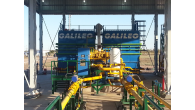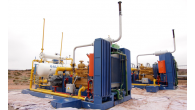Effective drilling
In the last few years a tend towards transition of drilling rigs from diesel consumption to cheaper natural gas is gaining worldwide popularity. This technology had existed before then, but the fall in oil prices at the end of 2014 forced mining companies to look for ways to reduce operating costs more actively. For example, in the USA about a third of the companies use gas to generate electricity necessary for drilling operations. In Ukraine this technology has not yet found its application, though with our high prices for diesel, investments in equipment for the LNG or CNG production could have paid off in just a few years. According to experts’ opinion, the market is waiting for the first successful project.
Eugene Skrybka
|
|
For a long time, drilling rigs around the world functioned using electricity, generated by diesel generators. Usually the drilling rig is equipped by three generators that burn expensive diesel fuel 24 hours a day. But it was over before 2010s, when the governments of developed countries started tightening environmental standards, including limiting the flaring of associated gas. Then engaged in oil production companies, that didn’t have access to gas pipelines, reflected on possibility of effective use of gas, thereby reducing the cost of hydrocarbon production and emissions of greenhouse gases into the atmosphere. In early 2010, the US corporation General Electric (GE), one of the world's largest |
companies in terms of market capitalization, actively started promoting gas and dual-fuel generators for power generation, as well as related equipment, among drilling companies in the US. GE tried to press hard another giant — Caterpillar, whose diesel generators have long served as a standard for service companies. However, Caterpillar has also expanded its range of gas generator models.
In 2013, the trend towards the transition of drilling companies to gas in the US began gaining momentum. With the prices for diesel fuel of that time, switching of one drilling rig with three generators to gas allowed to save about $ 1.8 million per year, Reuters reported referring to GE data. At the end of 2014, the prices of oil and oil products began declining, and along with them the revenues of oil and gas companies decreased.
It’s widespread
In 2014-2015, the growth in the number of drilling rigs, working on gas, accelerated. "When oil prices fell, the operators of the exploration and production sector started looking for various ways of reducing operating costs," — Head of the CIS office Galileo Technologies S.A. Alexander Pototskii told for NefteRynok. His company is based in Argentina, but supplies technologies and mobile equipment for working with natural gas (LNG, CNG) to customers from 70 countries in Latin America, USA, Europe and Asia. According to Galileo Technologies, the number of dual-fuel drilling platforms in North Dakota increased in 2014-2015 from 14 to 30%."The same situation is in the South in Texas, and in the Marcellus field in the West," — the top manager added. We note that during this period, the authorities of some US states tightened restrictions on flaring gas, in particular in North Dakota, which also stimulated drillers to effectively use associated gas.
| We note that during this period, the authorities of some US states tightened restrictions on flaring gas, in particular in North Dakota, which also stimulated drillers to effectively use associated gas. For example, in the autumn of 2014, the Norwegian Statoil, operating at the Bakken field in North Dakota, announced about expanding the use of CNG as a fuel for drilling rigs in cooperation with GE Oil & Gas. The company used a system that allowed taking gas from a well, taking out propane and butane separately, and compressing the remaining natural gas and feeding it into storage tanks. Then this gas is transported by gas carriers to nearby places of consumption. Reportedly, Statoil used bi-fuel generators that can operate on a mixture of LNG and diesel fuel, which reduces the consumption of diesel by about 50%. In addition to drilling rigs generators, LNG can be used in drilling fluids heating utins, especially in winter, and in hydraulic fracturing units. |
|
As noted by Alexander Pototskii, all these technologies are successfully used not only in the US, but also in Canada and Australia — in the most competitive markets, where the cost price of oil and gas production is of critical importance. It should be noted, that GE has also entered the Chinese market where it cooperates with one of the largest manufacturers of drilling rigs — the Chinese Honghua Group. The first drilling rigs, functioning on natural gas, appeared in China in early 2016 and were utilized in the shale gas deposits, developed by Sinopec.
From any gas
For power generation, necessary for the work of drilling rig, it is possible to use natural gas, obtained either from associated petroleum gas, either from a gas well or from a pipeline. In any case, it is economically advantageous, since 1 m³ of natural gas has approximately the same calorific value as 1 thousand liters of diesel fuel. At the same time, prices for diesel fuel are much higher. However, in order to use gas as fuel, it’s necessary to condition it, bringing it to the state of LNG or CNG. Appropriate equipment requires investments, which, however, pay off fairly quickly. "In order to produce LNG from associated gas, weathering gas or gas that goes directly from the deposit, the gas must be treated from so-called acid gases, sulfur and nitrogen, to bring its composition as close to CO2 as possible, — explains Alexander Pototskii. — Then the gas goes to the liquefaction plant, where its temperature drops to minus 160 degrees, and after that the LNG can be pumped into gas carriers and transported to the destination points." Thus, in order to autonomously produce LNG, the drilling company will need a module for gas treating, a module for its compression and storage tanks for transportation. According to the manager, the rig uses on average 5 tons of diesel fuel per day, whereas the capacity of the module for the LNG production by Galileo Technologies is about 15 tons of LNG per day (about the same in diesel equivalent). Thus, one module can simultaneously service three drilling rigs. Economically, the installation of modules for the production of LNG directly at the field justifies itself quickly enough. According to Pototskii, the payback period of such investments is from 2 to 5 years. At the same time, mobile modules for LNG production have a number of advantages in comparison with stationary plants. First of all, they allow to set up the production of LNG quite quickly. According to the expert, only the construction of the plant will take about two years. In addition, obtaining permits and approvals from government agencies can take a long time — from one year to several years.
Price ratio
If we compare the price situation in Ukraine and the United States, where this technology is widely used nowadays, the conditions in our country are even more favorable. The difference in prices for natural gas and diesel fuel in the US is minimal, since the retail price of diesel fuel is quite low — about $ 0.65 per liter (17.8 UAH/liter). In Ukraine, according to the consulting company UPECO, in January this year the average retail cost of diesel fuel was 21.36 UAH/liter and in February prices continued to rise. As noted by Alexander Pototskii, in order to drill a well of 5 thousand meters depth, it is necessary to burn about 1 thousand tons of diesel fuel. Last year, the average wholesale price of diesel fuel, according to UPECO, was about 15.5 thousand UAH/ton, that is, drillers had to spend for these work about 15.5 million UAH. As reported the commercial director of Ukrgazdobycha Sergey Fedorenko at a press conference on Thursday, his company is going to purchase about 35 thousand tons of diesel fuel for its needs this year. A significant portion of this volume accounts for drilling rigs maintenance. At the same time, the price of natural gas in Ukraine is on average twice as low as of diesel fuel. Indeed, they are highly prone to seasonal fluctuations. According to expert Gennady Kobal from the consulting company ExPro, if in summer the price of gas was 5,8 thousand UAH/thous. m³, then in the winter it rose to 9.1 thousand UAH/thous. m³.
Economy in anticipation
The use of dual-fuel generators for drilling rigs allows reducing fuel consumption to 80%, explains Alexander Pototskii, adding that when gas is replaced by about 60% of diesel fuel, the savings can be more than 50%. If the economic justification for substituting diesel fuel for gas is obvious, the logical question arises: why this trend has not yet come to Ukraine or other countries of Eastern Europe? According to Pototskii, in the US and Canada, for example, there are many medium and small companies in the mining sector that quickly react to changes in working and price conditions. At the same time, in the post-Soviet space, state companies or enterprises with a large structure mainly operate and they need long time for decision-making. In addition, the availability of technology also plays its important role. According to Gennady Kobal, the Ukrainian market has its own characteristics, which hamper the introduction of new technologies. One of the main ones is that the drilling fleet is outdated. It can be said that about 90% of drilling rigs are in poor condition. Probably, no one is in a hurry to invest money in scrap metal servicing. In addition, drilling operators are often companies that do not own gas, but it up to them to decide on investments in the production of LNG or CNG. Nevertheless, Ukrainian companies are examining the solutions that make it possible to increase the efficiency of their work. "We have an interest in such technologies," — Pototskii said. — The question is who will take the first step, who will start the development of this new trend for Ukraine. For now the market is waiting." According to him, despite the external simplicity, such projects require a deep study and are always calculated individually. For companies like Ukrgazdobycha, which regularly drills and spends quite large sums for the purchase of diesel fuel, the transition to gas consumption could quickly pay off. "This technology looks attractive, — "Kobal says. —We need a successful case."
Source: NefteRynok №6, 13 february 2017













